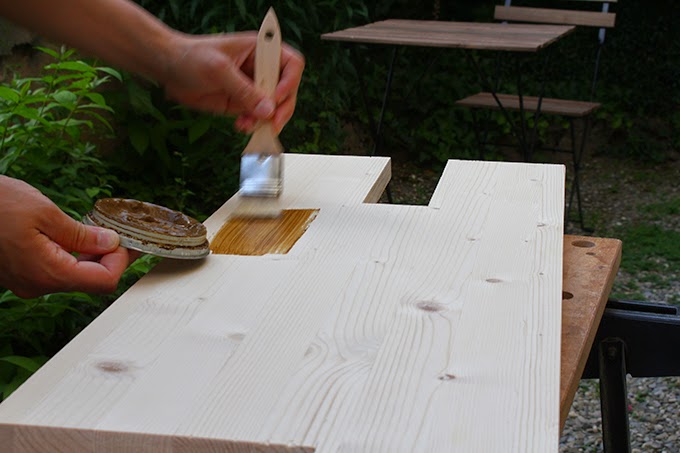I am staining my pine boards with a pigmented oil. The label on the can says "oak". I am quite conflicted about this.
This blog began from the premise that every material has essential qualities that should not be imitated. These qualities are much more than visual- they include texture, density, reaction to outside forces (weather), and methods of working and tooling. There is absolutely no way of making an oak shelf from a pine board.
In French, the word for "species" of wood is "essence". But in English, the word means a core substance that concentrates all the qualities of something. By colouring my boards, am I denying their essence- in both senses of the term?
But it is sometimes hard to decide what actions suppress the essence of a material, and what actions simply bring out its latent characteristics. For example, when I oiled my door handle, the wood became darker and more lustrous. I was amazed to see and feel how different the walnut was after oiling- almost like another substance.
I picked this oil not because I wanted my pine boards to be oak, but because I wanted them to look darker. I didn't like how light they are compared to the rest of my furniture. Applying the oil highlights the grain of the pine and all of its variations, knots, checks, chips and all. It will also (says the can) protect the wood and make it easier to clean. Perhaps 'untreated pine' and 'treated pine' have different essences? Alchemy, or camouflage?
This blog began from the premise that every material has essential qualities that should not be imitated. These qualities are much more than visual- they include texture, density, reaction to outside forces (weather), and methods of working and tooling. There is absolutely no way of making an oak shelf from a pine board.
In French, the word for "species" of wood is "essence". But in English, the word means a core substance that concentrates all the qualities of something. By colouring my boards, am I denying their essence- in both senses of the term?
But it is sometimes hard to decide what actions suppress the essence of a material, and what actions simply bring out its latent characteristics. For example, when I oiled my door handle, the wood became darker and more lustrous. I was amazed to see and feel how different the walnut was after oiling- almost like another substance.
I picked this oil not because I wanted my pine boards to be oak, but because I wanted them to look darker. I didn't like how light they are compared to the rest of my furniture. Applying the oil highlights the grain of the pine and all of its variations, knots, checks, chips and all. It will also (says the can) protect the wood and make it easier to clean. Perhaps 'untreated pine' and 'treated pine' have different essences? Alchemy, or camouflage?




Comments
Post a Comment